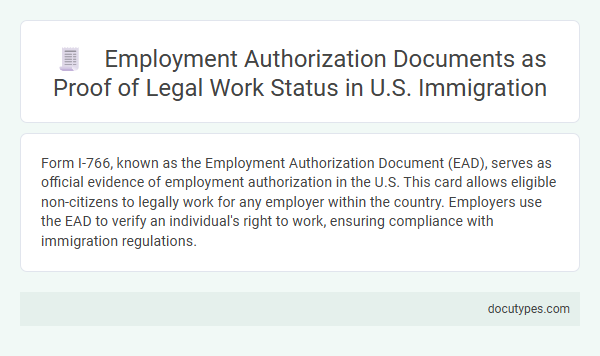Form I-766, known as the Employment Authorization Document (EAD), serves as official evidence of employment authorization in the U.S. This card allows eligible non-citizens to legally work for any employer within the country. Employers use the EAD to verify an individual's right to work, ensuring compliance with immigration regulations.
Understanding Employment Authorization Documents (EADs)
The Employment Authorization Document (EAD), issued by the U.S. Citizenship and Immigration Services (USCIS), serves as official evidence of your authorization to work in the United States. This plastic card contains personal information and an expiration date, verifying legal employment status for eligible non-citizens. Understanding the importance and proper use of the EAD helps ensure compliance with employment laws and streamlines the hiring process.
Legal Significance of EADs in U.S. Immigration
| Form Name | Employment Authorization Document (EAD) |
|---|---|
| Official Form Number | I-766 |
| Purpose | Serves as proof of an individual's authorization to work legally in the United States. |
| Issuing Authority | U.S. Citizenship and Immigration Services (USCIS) |
| Legal Significance |
The EAD functions as a federally recognized identification that verifies employment eligibility. It enables non-citizens such as asylum seekers, DACA recipients, and certain visa holders to work lawfully. Employers rely on the EAD to complete Form I-9, ensuring compliance with immigration laws. Possession of an EAD protects workers from unauthorized employment penalties and supports lawful status maintenance. |
| Validity Period | Varies by applicant category; typically one to two years with possible renewal options. |
| Who Can Apply | Asylees, refugees, Temporary Protected Status (TPS) holders, DACA recipients, spouses of certain visa holders, and other eligible noncitizens. |
Eligibility Criteria for Employment Authorization
The Form I-766, known as the Employment Authorization Document (EAD), serves as evidence of employment authorization in the United States. Eligibility criteria depend on your immigration status, such as asylum seeker, DACA recipient, or certain visa holders.
- Asylum Seekers - Individuals granted asylum or with pending asylum applications may apply for employment authorization using Form I-765.
- DACA Recipients - Deferred Action for Childhood Arrivals beneficiaries are eligible for an EAD that allows them to work in the U.S. legally.
- Nonimmigrant Visa Holders - Certain nonimmigrant classifications, including students seeking Optional Practical Training or spouses of specific visa holders, qualify for employment authorization through this form.
How to Apply for an EAD
The Employment Authorization Document (EAD), also known as Form I-766, serves as evidence of employment authorization in the United States. This card proves the holder has legal permission to work temporarily in the U.S.
To apply for an EAD, you must complete and submit Form I-765 to the U.S. Citizenship and Immigration Services (USCIS). Include required supporting documents, such as proof of your immigration status and identity, along with the appropriate filing fee or fee waiver request.
Required Documentation for EAD Application
The Form I-766, known as the Employment Authorization Document (EAD), serves as official evidence of employment authorization in the U.S. It is essential for individuals seeking to prove their right to work legally while their immigration status permits.
- Form I-765 - This is the application form required to request an EAD from the U.S. Citizenship and Immigration Services (USCIS).
- Proof of Identity - A valid government-issued photo ID is necessary to verify the applicant's identity during the EAD application.
- Supporting Immigration Documents - Submission of documents such as Form I-94 or visa status proof is required to establish eligibility for employment authorization.
You must ensure all required documentation is complete and accurate to avoid delays in processing your EAD application.
EAD Validity and Renewal Process
The Employment Authorization Document (EAD), also known as Form I-766, serves as proof of your legal right to work in the United States. This card is issued by the U.S. Citizenship and Immigration Services (USCIS) and contains your photograph, personal details, and validity dates.
The EAD is typically valid for one year to two years, depending on your immigration status or eligibility category. To maintain continuous employment authorization, you must apply for renewal before the expiration date, generally 180 days in advance of the current EAD's expiry.
EADs as Proof of Legal Work Status for Employers
The Employment Authorization Document (EAD) serves as official evidence of an individual's legal right to work in the United States. Employers rely on the EAD to verify employment eligibility under U.S. immigration law. This form is issued by the U.S. Citizenship and Immigration Services (USCIS) to eligible noncitizens, providing proof of authorized employment status.
Common Issues and Delays with EADs
Which form serves as evidence of employment authorization in the U.S.? The Employment Authorization Document (EAD), issued using Form I-766, serves as proof that a non-citizen is allowed to work legally in the United States. Common issues with EADs include processing delays, lost or damaged cards, and errors on the document that can affect employment opportunities.
Legal Rights and Responsibilities with an EAD
The Employment Authorization Document (EAD) serves as official proof of your legal right to work in the United States. This form verifies employment authorization for various immigration statuses.
- EAD Form I-766 - This document functions as evidence of your employment eligibility granted by USCIS.
- Legal Work Permit - Holding an EAD allows you to legally accept employment from any U.S. employer.
- Responsibilities - You must maintain valid EAD status and comply with all U.S. employment laws while working.
Which Form Serves as Evidence of Employment Authorization in the U.S.? Infographic

